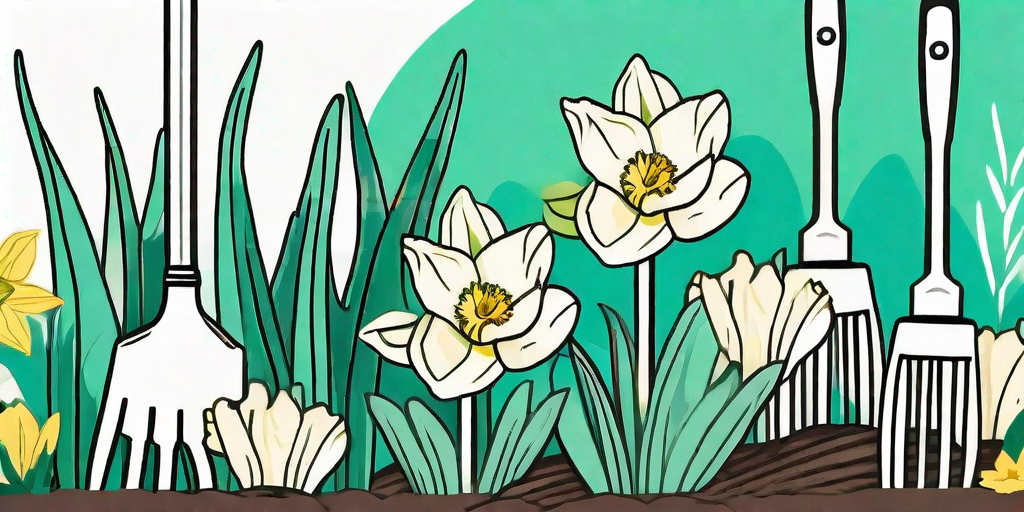
Welcome, green-thumbed enthusiasts and budding botanists! If you're looking to add a splash of sunshine to your garden with the vibrant hues of daffodils, you've come to the right place. This guide will walk you through the process of growing these dazzling springtime favourites from seed to bloom. So, grab your gardening gloves, and let's get started!
Understanding the Daffodil
Before we dive into the planting process, it's important to get to know our subject a little better. Daffodils, or Narcissus if you want to get all scientific about it, are a genus of predominantly spring perennial plants. They're a part of the Amaryllidaceae family, which they share with other favourites like snowdrops and amaryllis.
These hardy little flowers are native to meadows and woods in southern Europe and North Africa, but they've made themselves quite at home in gardens around the world. Daffodils are known for their vibrant yellow or white trumpet-shaped flowers that seem to announce the arrival of spring.
The Symbolism of Daffodils
Did you know that daffodils carry a lot of symbolism? In ancient times, they were linked to death and the underworld, but don't let that put you off! These days, they're more commonly associated with rebirth and new beginnings, thanks to their early appearance in the spring. They're also the birth flower for March, so if you have any Pisces or Aries friends, you know what to get them!
And let's not forget the famous poem by William Wordsworth, where he waxes lyrical about a host of golden daffodils fluttering and dancing in the breeze. If that doesn't inspire you to plant these beauties, I don't know what will!
Getting Started with Daffodil Planting
Now that we're well-acquainted with our floral friend, let's get down to the nitty-gritty of planting daffodils. Fear not, dear reader, for the process is simpler than you might think!
First things first, you'll need to get your hands on some daffodil bulbs. These can be bought from any garden centre or online. And remember, the bigger the bulb, the bigger the bloom!
Choosing the Right Location
Daffodils are pretty easy-going, but they do have a few requirements when it comes to location. They prefer a spot with full or partial sun and well-drained soil. If your garden is more clay than sand, don't despair! Just add some organic matter, like compost or well-rotted manure, to improve the drainage.
And don't forget about spacing. Daffodils like to have a little room to breathe, so make sure to plant the bulbs about 3-6 inches apart. This will give them enough space to grow without competing for resources.
Planting the Bulbs
When it comes to planting, timing is everything. Daffodil bulbs should be planted in the fall, about 2-4 weeks before the ground freezes. This gives them enough time to establish roots before the winter chill sets in.
To plant the bulbs, dig a hole about 3 times the height of the bulb and place it in the hole with the pointy end facing up. Then, cover it with soil and water thoroughly. Easy peasy, right?
Caring for Your Daffodils
Once your bulbs are snug in the ground, the hard work is mostly done. But there are still a few things you can do to ensure your daffodils thrive.
Water your daffodils regularly, especially during dry spells. However, be careful not to overwater, as this can lead to bulb rot. Once the flowers have bloomed, you can cut them back but leave the leaves. These will continue to photosynthesize and store energy for next year's flowers.
Fertilizing Your Daffodils
While daffodils aren't particularly fussy about their soil, they will appreciate a little feeding. A slow-release bulb fertilizer can be added at planting time to give them a good start. After that, a yearly top-up in the fall should keep them happy.
Just remember, over-fertilizing can lead to lush, leafy growth at the expense of flowers, so don't go overboard!
Common Daffodil Problems and How to Solve Them
Despite their hardy nature, daffodils can sometimes run into problems. But don't worry, we've got you covered with solutions to the most common issues.
Bulb Rot
If your daffodils are failing to emerge in the spring, bulb rot could be the culprit. This is often caused by overwatering or poor drainage. To prevent this, ensure your daffodils are planted in well-drained soil and don't water them too much, especially during the winter.
Pests
While daffodils are generally resistant to pests, they can sometimes be bothered by slugs, snails, and narcissus bulb fly. To keep these critters at bay, try using a natural slug and snail deterrent and keep an eye out for any flies hovering around your bulbs.
FAQs
- When is the best time to plant daffodils?
The best time to plant daffodils is in the fall, about 2-4 weeks before the ground freezes. - How deep should I plant daffodil bulbs?
Daffodil bulbs should be planted about 3 times their height deep. This usually equates to about 4-6 inches. - How often should I water my daffodils?
Water your daffodils regularly, especially during dry spells. However, be careful not to overwater, as this can lead to bulb rot. - Do daffodils need a lot of sun?
Daffodils prefer a spot with full or partial sun. However, they can tolerate some shade, especially in hotter climates.
Conclusion
And there you have it, folks! A comprehensive guide to growing dazzling daffodils. With a bit of care and attention, you'll be rewarded with a host of golden blooms come spring. So, what are you waiting for? It's time to get planting!
Remember, gardening is a journey, not a destination. So, enjoy the process, learn from your mistakes, and don't forget to stop and smell the daffodils!















